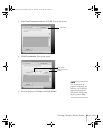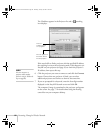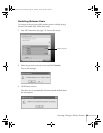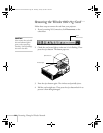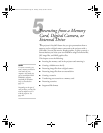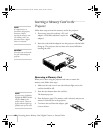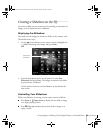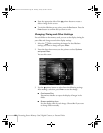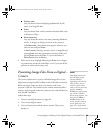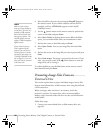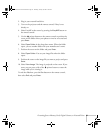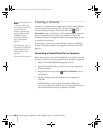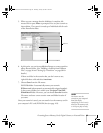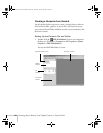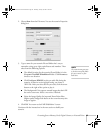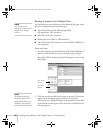
Presenting from a Memory Card, Digital Camera, or External Drive 89
■ Display order
Lets you choose between displaying alphabetically by file
name or by image file date.
■ Effect
Lets you choose from various transitions between slides, such
as Dissolve or Wipe.
■ Mode switching
Lets you choose the mode to use when presenting slideshows,
movies, or images, or editing a scenario on the projector.
In
Guide mode, a drop-down menu appears whenever you
select an item and press
Enter.
In
Quick mode, selecting a scenario, movie, or image file and
pressing
Enter starts the presentation; selecting a folder and
pressing
Enter opens the folder. To access the menus in
Quick mode, press the Esc key.
4. When you’re done, highlight
OK and press Enter. Your changes
are permanently saved with each folder—even if you turn off the
projector or remove the memory card.
Presenting Image Files From a Digital
Camera
This section explains how to project individual image files on your
digital camera using EasyMP CardPlayer and a USB cable connection.
Before you begin, make sure there is no memory card in the
projector’s card slot. You cannot have the camera connected while a
memory card is inserted; neither the camera nor the card will function
with EasyMP CardPlayer.
Follow these steps:
1. Connect your digital camera (see page 46).
2. Turn on your digital camera.
3. Turn on the projector and the remote control, if they’re not
already on.
note
Most digital cameras also
have the ability to play
internal slideshows.
Depending on the kind of
cable you have, you can
connect a camera with a
video or A/V out port to the
projector’s
Video or
S-Video port and transmit
your camera’s slideshow
directly to the projector. You
must press the
Video or
S-Video button on the
remote control to select the
correct signal source. See
pages 42 or 43 for details.
Banff-Toronto User's Guide.book Page 89 Thursday, January 20, 2005 5:00 PM



